Experimental Investigation on the Effect of Varying Fiber Mix Proportion on the Mechanical and Thermal Performances of Fiber-Reinforced Self-Compacting Concrete under Hydrocarbon Fire Condition
Abstract
:1. Introduction
2. Standard Fire Tests
3. Material and Properties, Specimen Casting, and Testing
3.1. Materials
3.2. Mix Design
3.2.1. Mixing of Concrete, Preparation, and Casting of Specimens
3.2.2. Mixing and Casting of Concrete
3.3. Fire Exposure Test
4. Results and Discussions
4.1. Performance of Slabs upon Exposure to Fire
4.2. Effects of Fire on Mechanical Properties
4.2.1. Compressive Strength Development
4.2.2. Effects of Fire on the Microstructure
5. Conclusions
Author Contributions
Funding
Acknowledgments
Conflicts of Interest
References
- Das, A.K. Principles of Fire Safety Engineering: Understanding Fire and Fire Protection; PHI Learning Private Limited: Delhi, India, 2014. [Google Scholar]
- Gross, J.L.; Phan, L.T. Summary of Best Practice Guidelines for Structural Fire Resistance Design of Concrete and Steel Buildings. Struct. Congr. 2010 2010, 2369–2379. [Google Scholar] [CrossRef]
- Khoury, G.A. Effect of fire on concrete and concrete structures. Prog. Struct. Eng. Mater. 2000, 2, 429–447. [Google Scholar] [CrossRef]
- Kodur, V.; Raut, N. Performance of concrete structures under fire hazard: Emerging trends. Indian Concr. J. 2010, 84, 23–31. [Google Scholar]
- Tucker, D.; R.E.H. Read ARICS. Assessing fire-damaged structures. Struct. Surv. 1983. [Google Scholar] [CrossRef]
- Kodur, V.; Phan, L. Critical factors governing the fire performance of high strength concrete systems. Fire Saf. J. 2007, 42, 482–488. [Google Scholar] [CrossRef]
- Salih, A.F.M. Performance of Fiber-Reinforced Self-Compacting Concrete Containing Different Pozzolanic Material. Ph.D. Thesis, Universiti Teknologi Petronas, Malaysia, 2014. [Google Scholar]
- Shafiq, N.; Nuruddin, M.F.; Khan, S.U.; Ayub, T. Calcined kaolin as cement replacing material and its use in high strength concrete. Constr. Build. Mater. 2015, 81, 313–323. [Google Scholar] [CrossRef]
- Shafiq, N. Degree of hydration and compressive strength of conditioned samples made of normal and blended cement system. KSCE J. Civ. Eng. 2011, 15, 1253–1257. [Google Scholar] [CrossRef]
- Alonso, M.C.; Sanchez, M.; Rodriguez, C.; Barragán, B. Durability of SCC reinforced with polymeric fibers: Interaction with environment and behavior against high temperatures. In Proceedings of the 11th International Inorganic-Bonded Fiber Composites Conferences, Madrid, Spain, 5–8 November 2008. [Google Scholar]
- Mohamed, R.N.; Zamri, N.F.; Rahman, A.B.A. Steel fiber self-compacting concrete under biaxial loading. Constr. Build. Mater. 2019, 224, 255–265. [Google Scholar] [CrossRef]
- Jadhav, H.; Patharwat, A. Investigation on residual compressive strength of self-compacting concrete using fibers under elevated temperature. Int. J. Struct. Civ. Eng. Res. 2013, 2, 155–164. [Google Scholar]
- Weerasinghe, P.; Nguyen, K.; Mendis, P.; Guerrieri, M. Large-scale experiment on the behavior of flat concrete slabs subjected to standard fire. J. Build. Eng. 2020, 101255. [Google Scholar] [CrossRef]
- Asadi, I.; Shafigh, P.; Bin Abu Hassan, Z.F.; Mahyuddin, N.B. Thermal conductivity of concrete – A review. J. Build. Eng. 2018, 20, 81–93. [Google Scholar] [CrossRef]
- Salari, Z.; Vakhshouri, B.; Nejadi, S. Analytical review of the mix design of fiber reinforced high strength self-compacting concrete. J. Build. Eng. 2018, 20, 264–276. [Google Scholar] [CrossRef]
- Al-Hadithi, A.; Hilal, N. The possibility of enhancing some properties of self-compacting concrete by adding waste plastic fibers. J. Build. Eng. 2016, 8, 20–28. [Google Scholar] [CrossRef]
- International Organization for Standardization. 834: Fire Resistance Tests-Elements of Building Construction; International Organization for Standardization: Geneva, Switzerland, 1999. [Google Scholar]
- ASTM. Standard Test Methods for Fire Tests of Building Construction and Materials; ASTM E119-07; ASTM International: West Conshohocken, PA, USA, 2000. [Google Scholar]
- ASTM. Standard Test Methods for Determining Effects of Large Hydrocarbon Pool Fires on Structural Members and Assemblies; ASTM E1529-06; ASTM International: West Conshohocken, PA, USA, 2006. [Google Scholar]
- Kodur, V.K.R. Spalling in High Strength Concrete Exposed to Fire: Concerns, Causes, Critical Parameters and Cures. Adv. Technol. Struct. Eng. 2000, 1–9. [Google Scholar] [CrossRef]
- Su, N.; Hsu, K.-C.; Chai, H.-W. A simple mix design method for self-compacting concrete. Cem. Concr. Res. 2001, 31, 1799–1807. [Google Scholar] [CrossRef]
- Okamura, H.; Ouchi, M. Self-compacting concrete. J. Adv. Concr. Technol. 2003, 1, 5–15. [Google Scholar] [CrossRef]
- British Standards Institution. Fire Tests on Building Materials and Structures-Part 20: Method for Determination of the Fire Resistance of Elements of Construction (General Principles); BS 476-20; British Standards Institution: London, UK, 1987. [Google Scholar]
- British Standards Institution. Testing Concrete in Structures. Cored Specimens. Taking, Examining and Testing in Compression; BS EN 12504–1; British Standards Institution: London, UK, 2009; p. 20. [Google Scholar]
- ASTM. Standard Test Method for Splitting Tensile Strength of Cylindrical Concrete Specimens; ASTM C496/C496M-04e1; Annual book of ASTM standards 2008: West Conshohocken, PA, USA, 2008; section 4. [Google Scholar]
- Azmee, N.; Shafiq, N. Ultra-high performance concrete: From fundamental to applications. Case Stud. Constr. Mater. 2018, 9. [Google Scholar] [CrossRef]
- Ayub, T.; Shafiq, N.; Khan, S.U. Compressive Stress-Strain Behavior of HSFRC Reinforced with Basalt Fibers. J. Mater. Civ. Eng. 2016, 28, 06015014. [Google Scholar] [CrossRef]
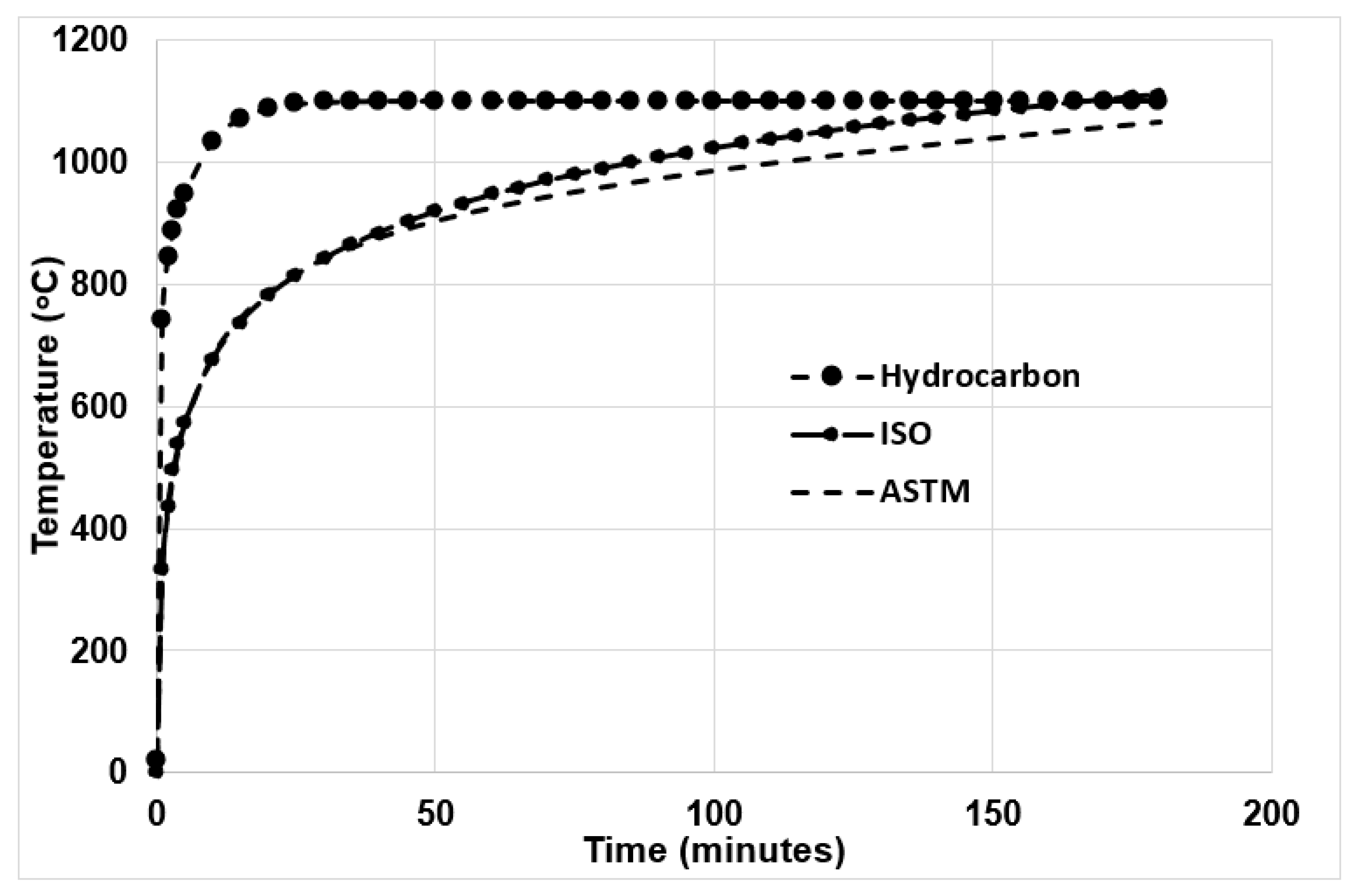
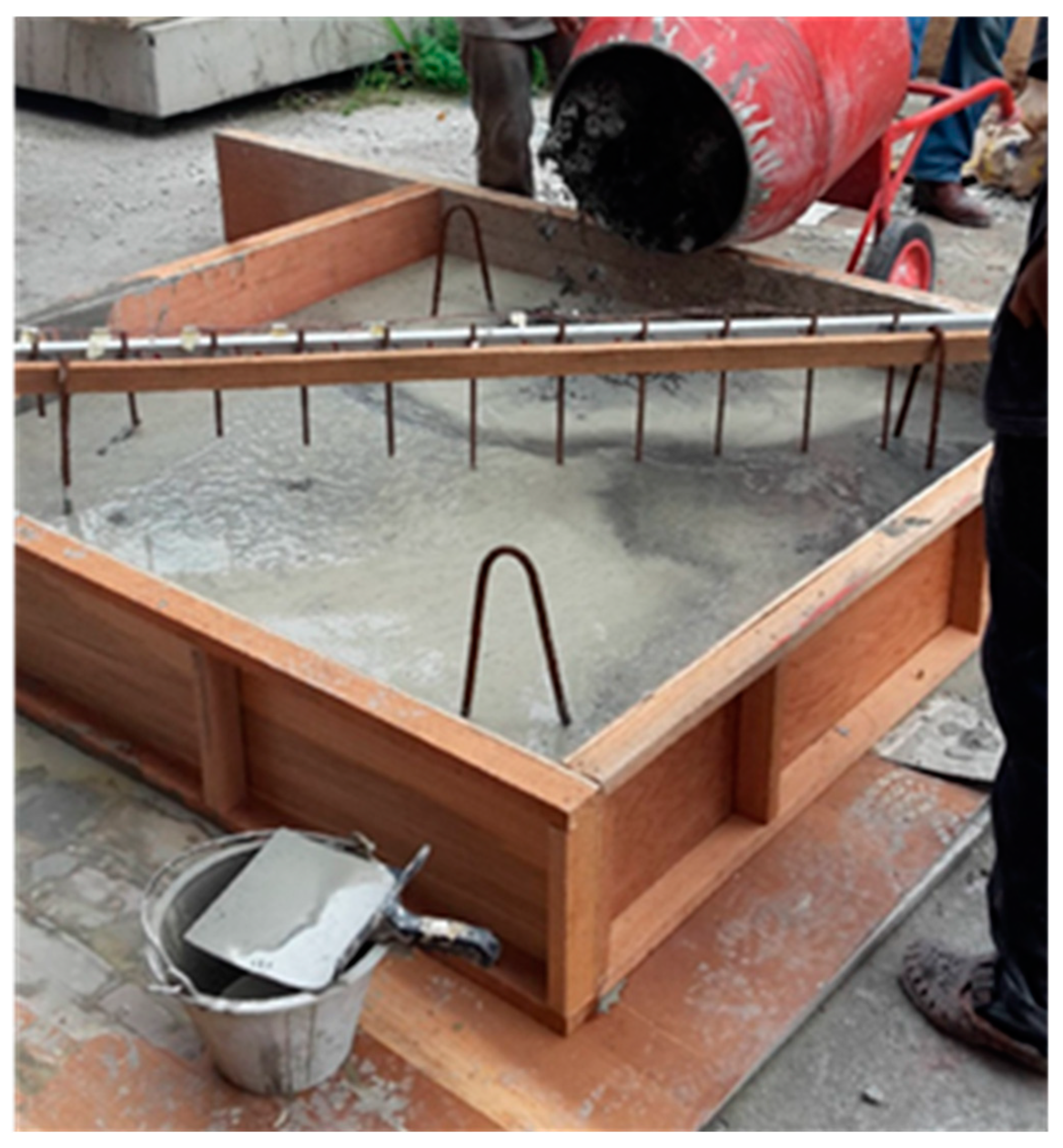
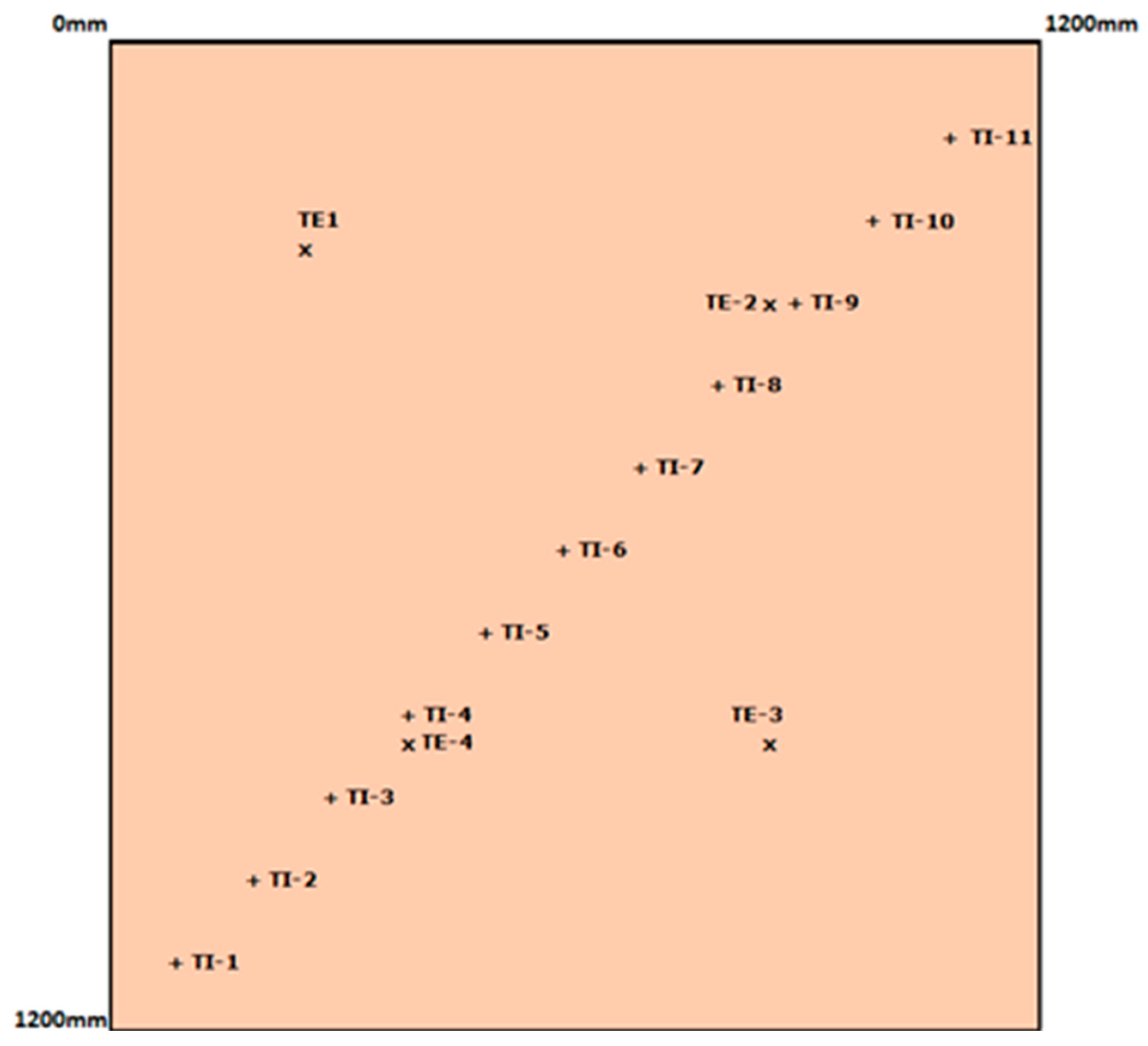


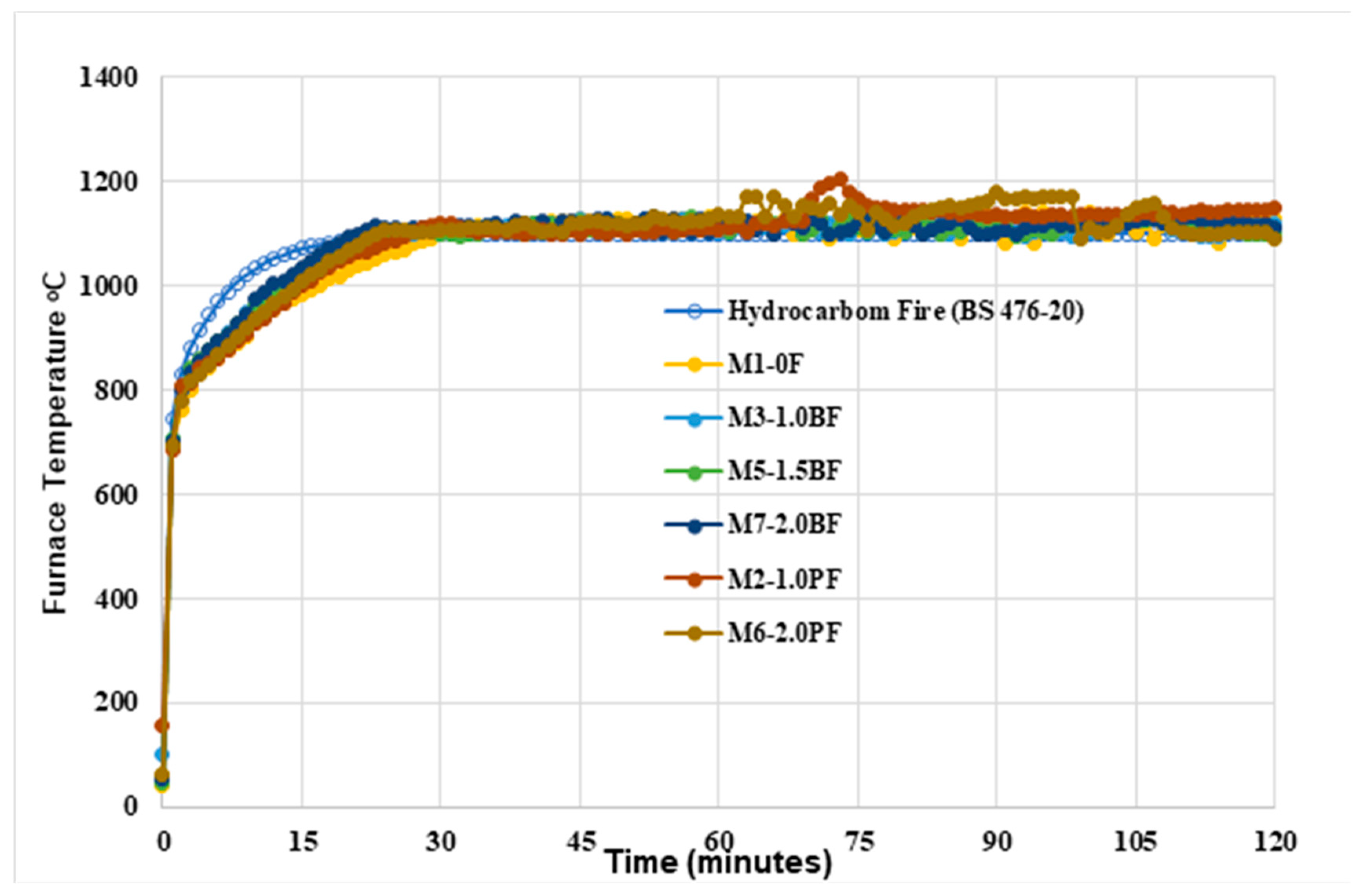
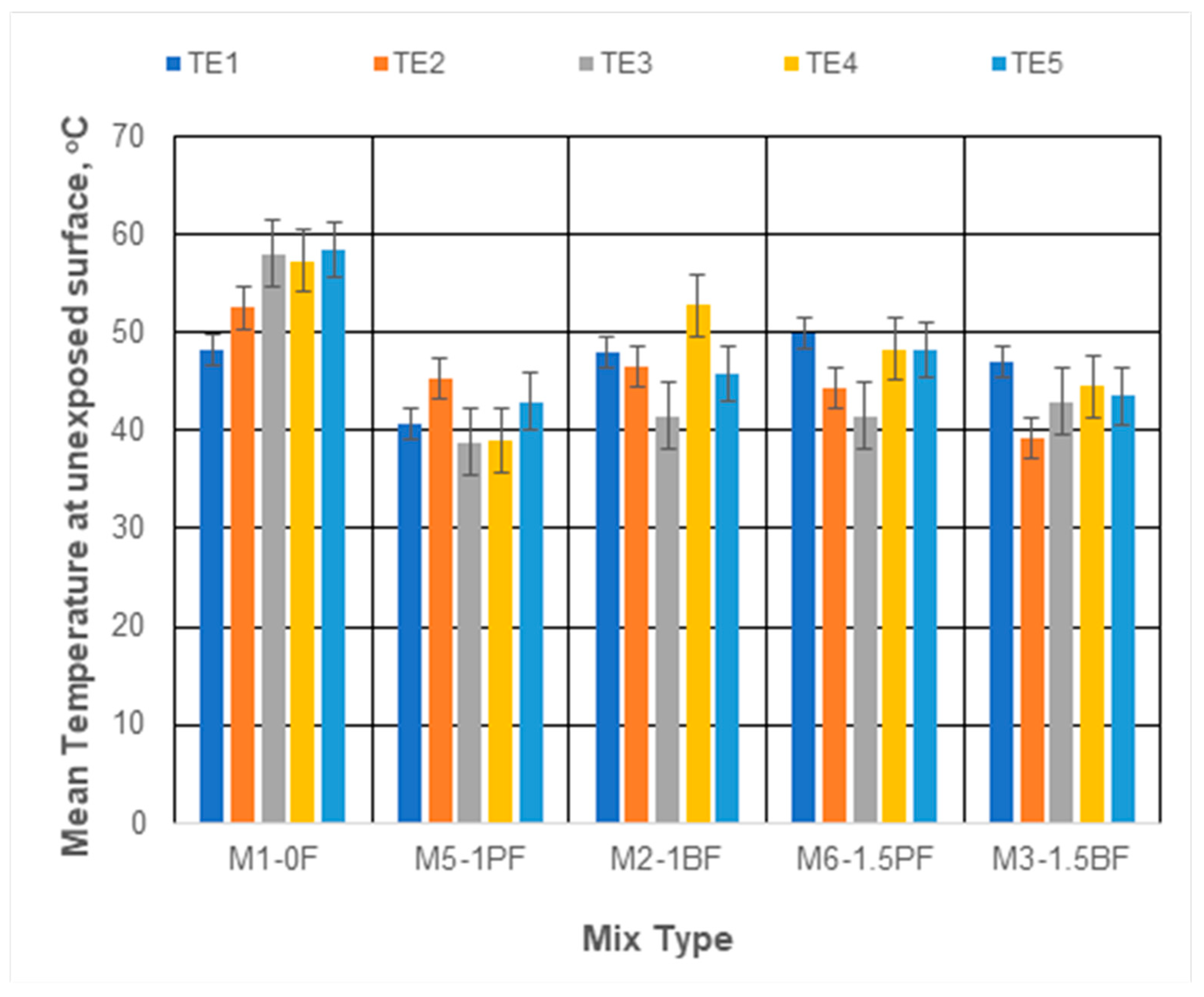
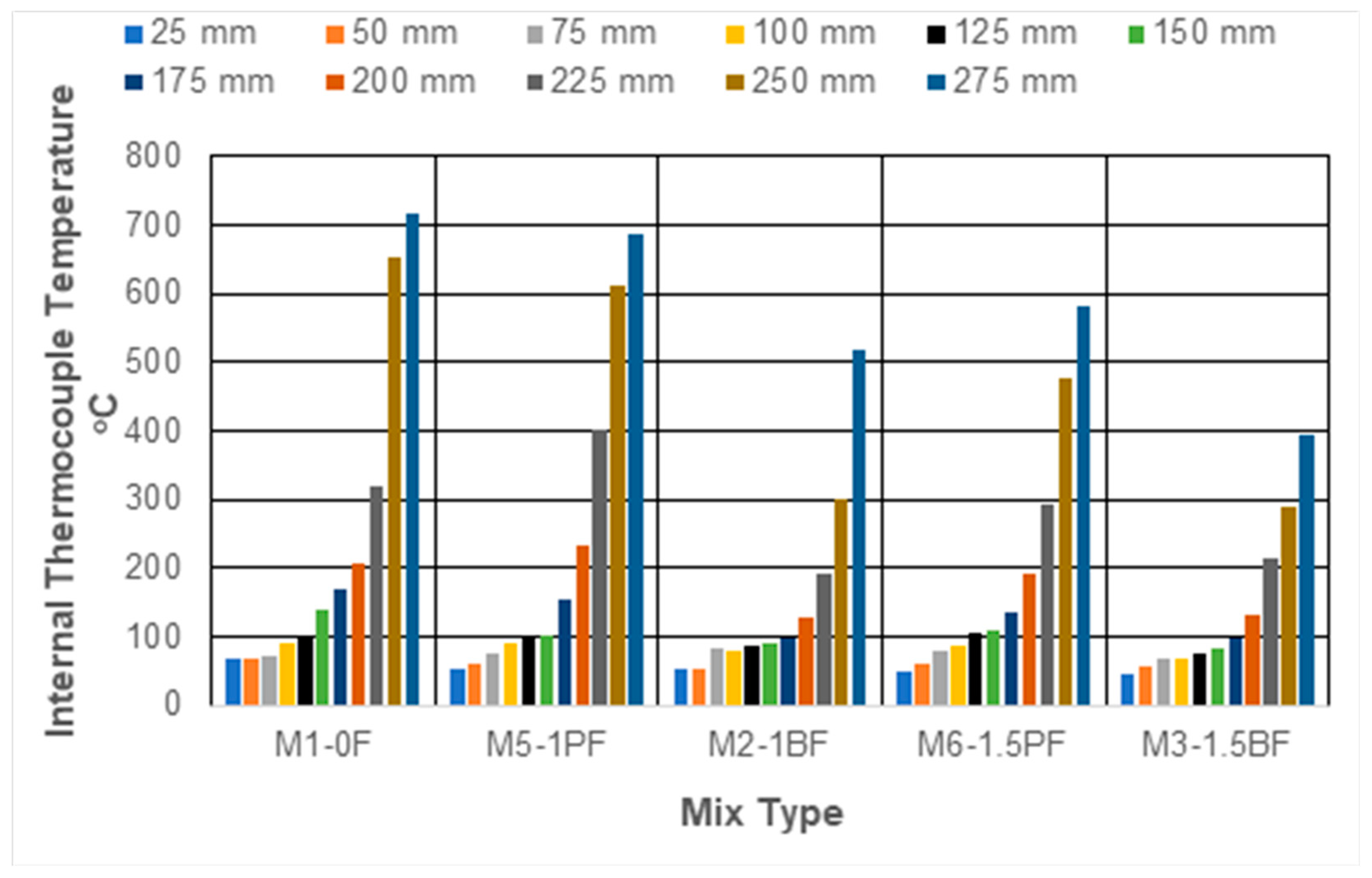

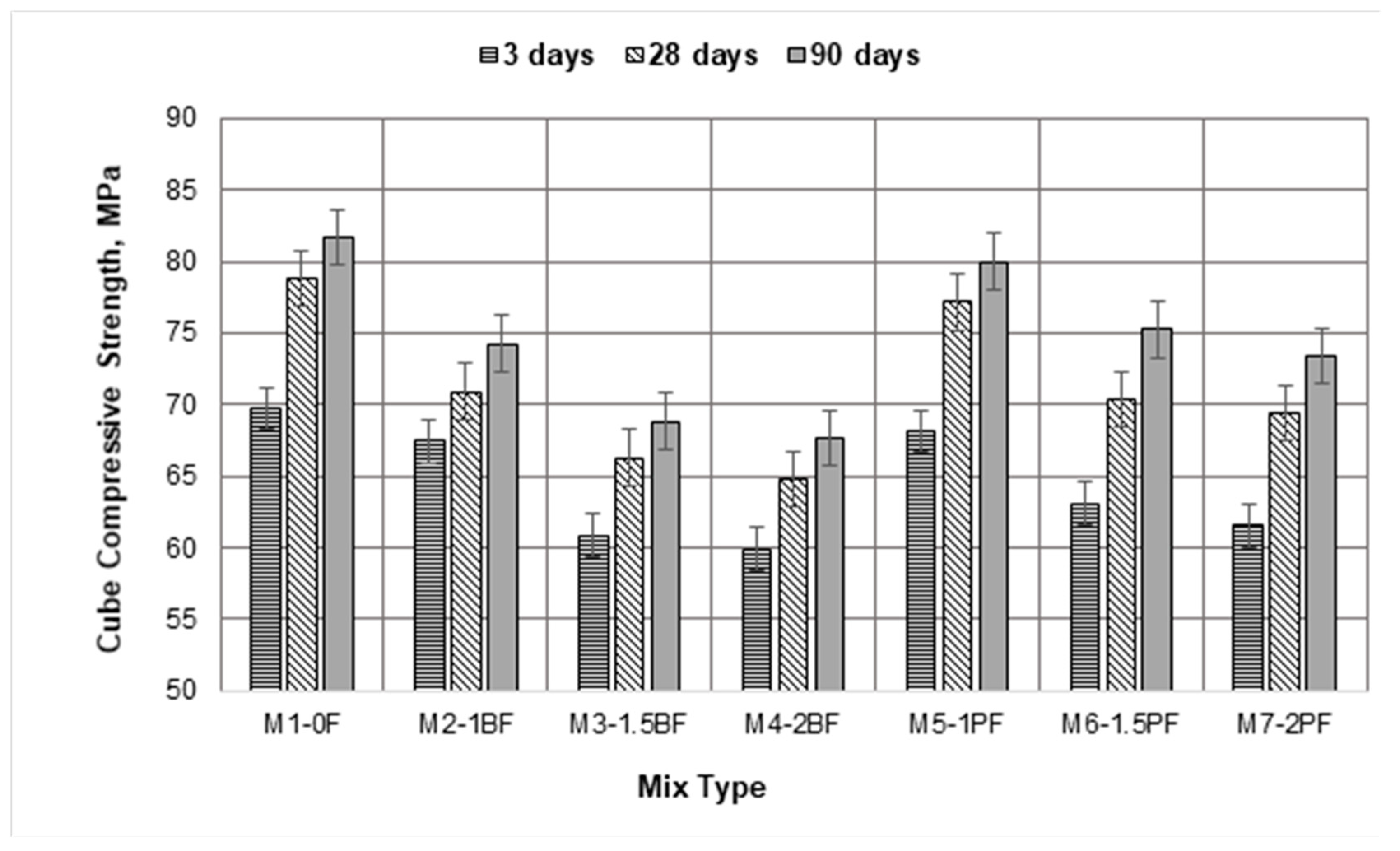
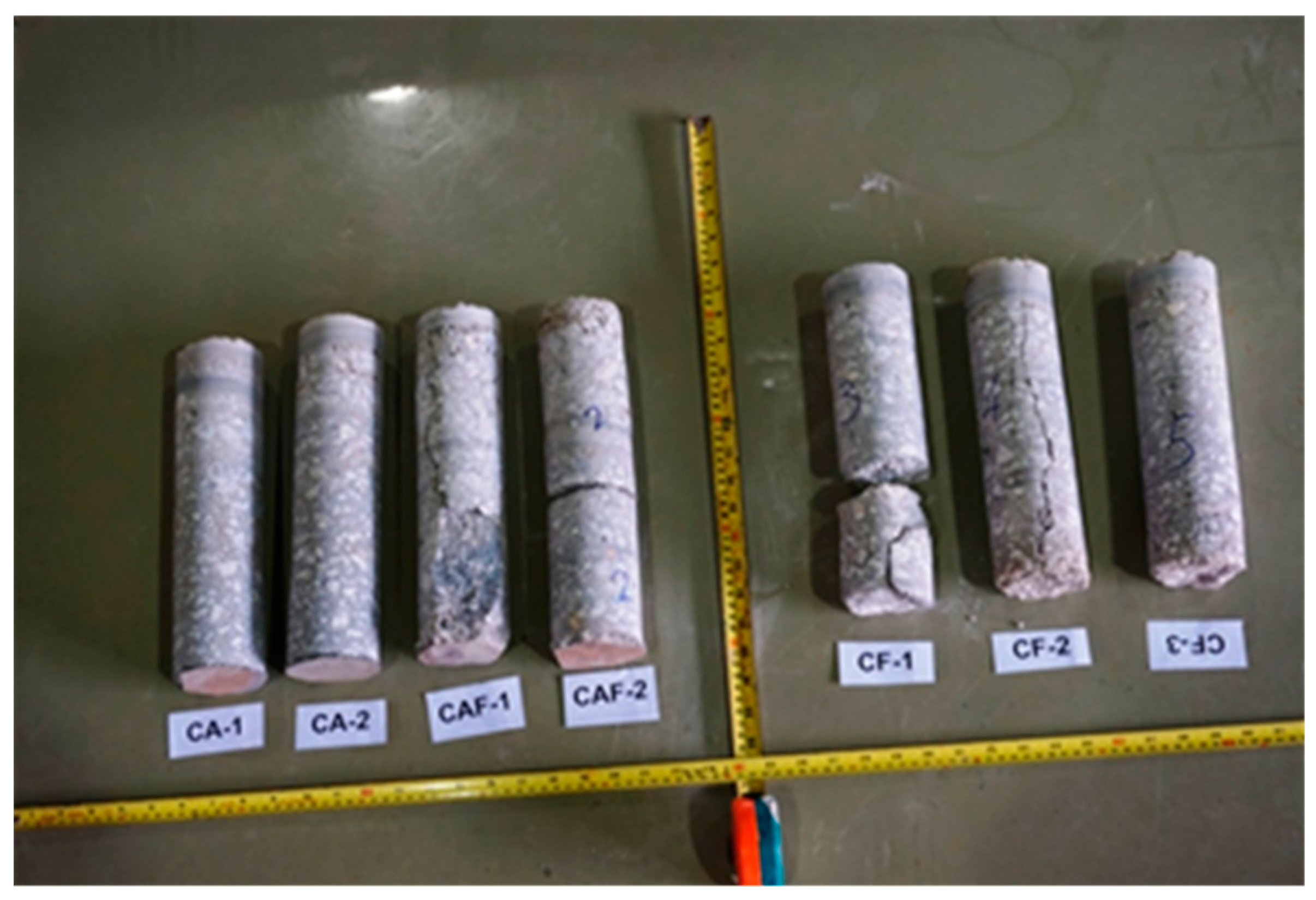
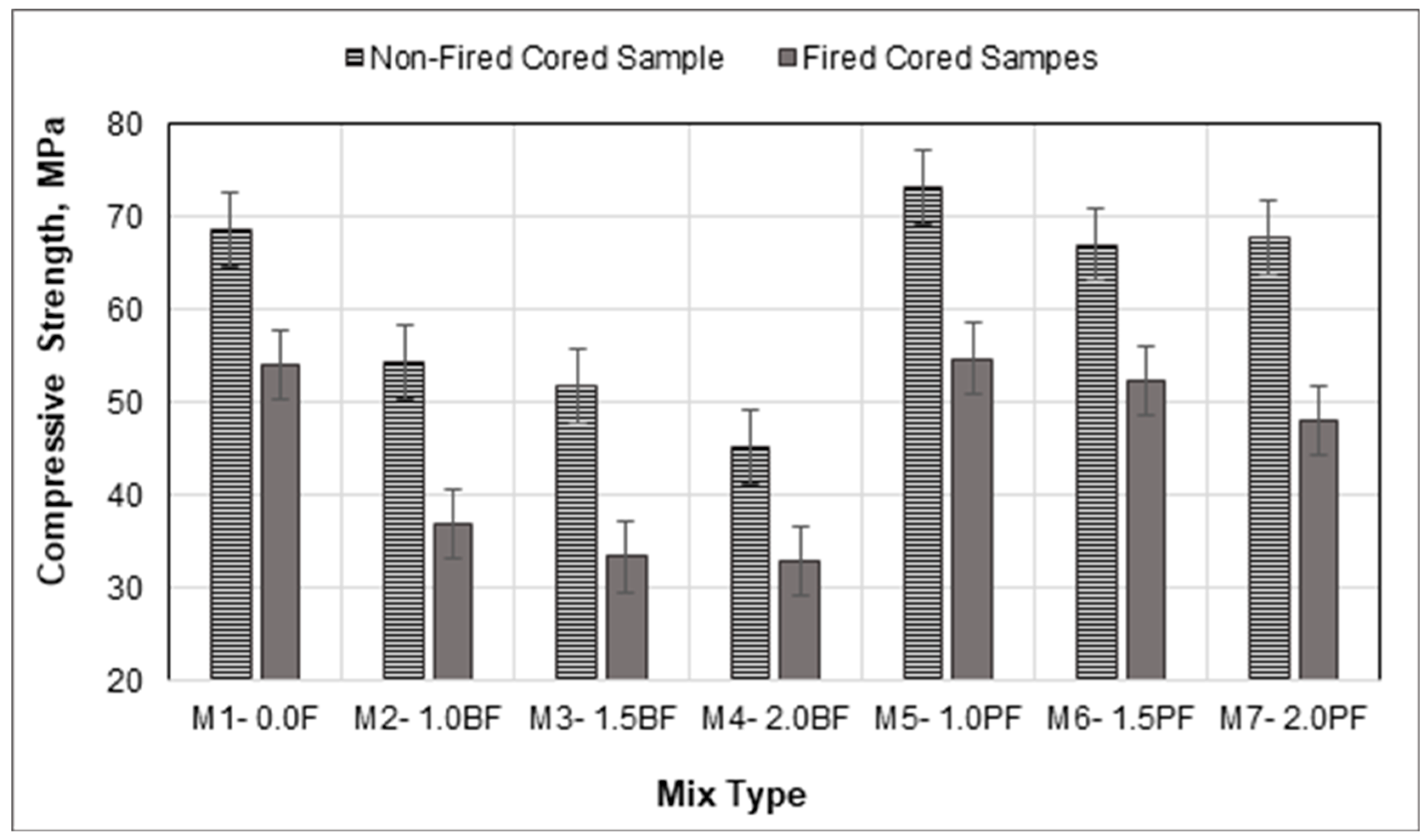

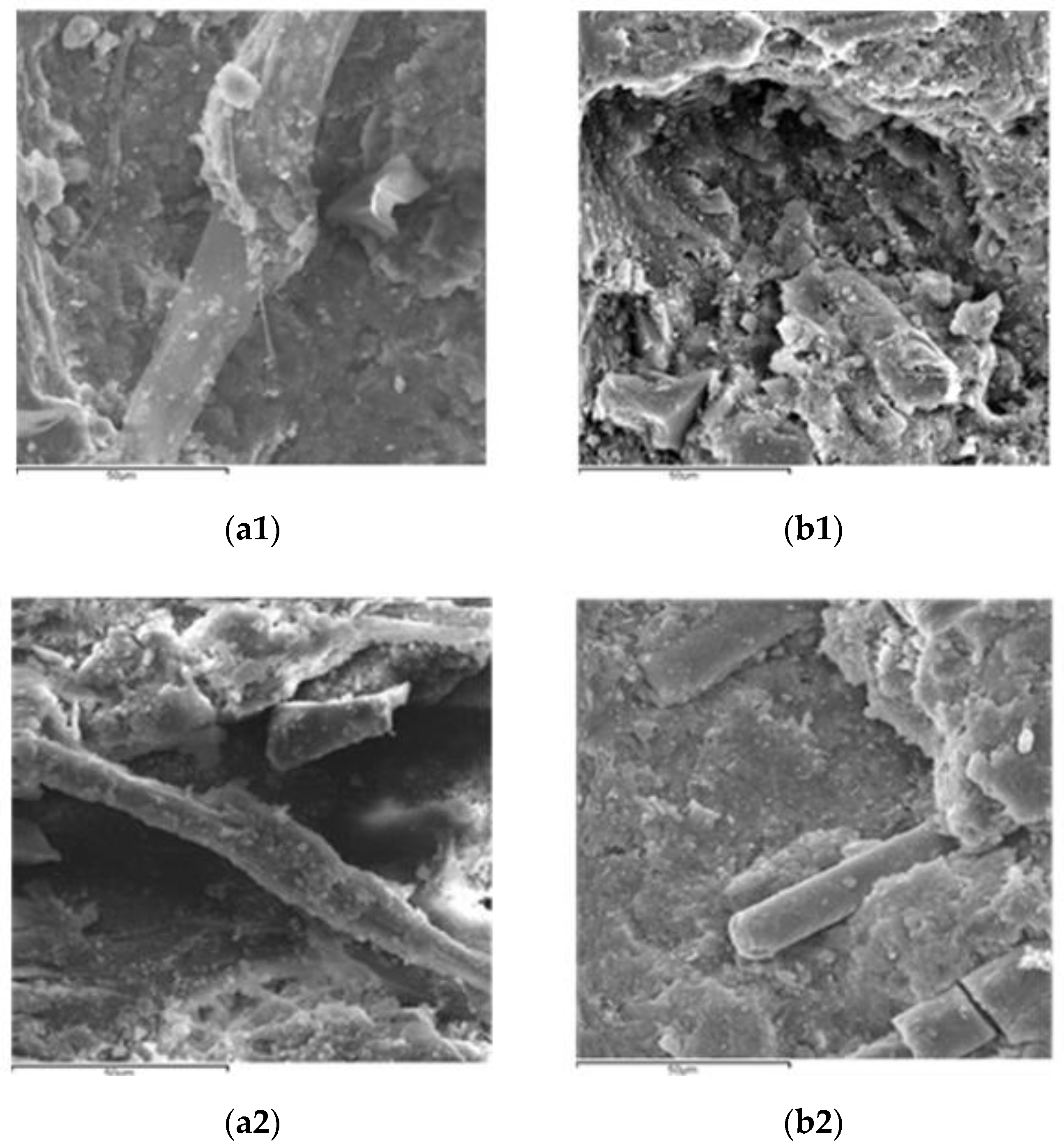

| Fiber Characteristics | Basalt Fiber | Polyvinyl Alcohol (PVA) Fiber |
|---|---|---|
| Length (mm) | 25.0 mm | 30.0 mm |
| Diameter (mm) | 0.00018 (0.18 μm) (138.89 aspect ratio) | 0.70 |
| Density (g/cm3) | 4100 to 4840 | 400 |
| Tensile strength (MPa) | 3200 | 455 |
| Elastic Modulus (MPa) | 100 to 110 | 24 to 40 |
| Color | dark brown | milky white |
| Mix Type | Cement | Fine Aggregate | Coarse Aggregate | Water | Superplasticizer | Fiber | W/C |
|---|---|---|---|---|---|---|---|
| Kg/m3 | Kg/m3 | Kg/m3 | Kg/m3 | % | % | ||
| M1-0F | 600 | 900 | 750 | 200 | 2 | 0 | 0.34 |
| M2-1BF | 600 | 900 | 750 | 200 | 2 | 1 | 0.34 |
| M3-1.5BF | 600 | 900 | 750 | 200 | 2 | 1.5 | 0.34 |
| M4-2BF | 600 | 900 | 750 | 200 | 2 | 2 | 0.34 |
| M5-1PF | 600 | 900 | 750 | 200 | 2 | 1 | 0.34 |
| M6-1.5PF | 600 | 900 | 750 | 200 | 2 | 1.5 | 0.34 |
| M7-2PF | 600 | 900 | 750 | 200 | 2 | 2 | 0.34 |
| Mix Type | Core Compressive Strength (Mpa) at 90 Days Curing (Average of 3 Samples) | Reduction in Strength (%) (After 120 min of Fire Exposure) | |
|---|---|---|---|
| Unfired Samples | Fired Samples | ||
| M1-0F | 68.7 | 54.2 | 21.1 |
| M2-1.0BF | 54.4 | 36.9 | 32.2 |
| M3-1.5BF | 51.9 | 33.4 | 35.6 |
| M4-2BF | 45.3 | 32.9 | 27.4 |
| M5-1PF | 73.3 | 54.8 | 25.2 |
| M6-1.5PF | 67.1 | 52.3 | 22.1 |
| M7-2.0PF | 67.8 | 48.2 | 28.9 |
| Mix Type | Split Cylindrical Tensile Strength (Mpa) at 90 Days Curing (Average of 3 Samples) | Reduction in Strength (%) (After 120 min of Fire Exposure) | |
|---|---|---|---|
| Unfired Samples | Fired Samples | ||
| M1-0F | 3.0 | 2.4 | 20.00 |
| M2-1.0BF | 3.5 | 2.7 | 22.86 |
| M3-1.5BF | 3.7 | 2.8 | 24.32 |
| M4-2BF | 2.9 | 2.4 | 17.24 |
| M5-1PF | 3.5 | 2.6 | 25.71 |
| M6-1.5PF | 4.1 | 3.2 | 21.95 |
| M7-2.0PF | 4.0 | 2.9 | 27.50 |
© 2020 by the authors. Licensee MDPI, Basel, Switzerland. This article is an open access article distributed under the terms and conditions of the Creative Commons Attribution (CC BY) license (http://creativecommons.org/licenses/by/4.0/).
Share and Cite
Mohammad Jani, N.; Shakir Nasif, M.; Shafiq, N.; Holt, I. Experimental Investigation on the Effect of Varying Fiber Mix Proportion on the Mechanical and Thermal Performances of Fiber-Reinforced Self-Compacting Concrete under Hydrocarbon Fire Condition. Appl. Sci. 2020, 10, 4586. https://doi.org/10.3390/app10134586
Mohammad Jani N, Shakir Nasif M, Shafiq N, Holt I. Experimental Investigation on the Effect of Varying Fiber Mix Proportion on the Mechanical and Thermal Performances of Fiber-Reinforced Self-Compacting Concrete under Hydrocarbon Fire Condition. Applied Sciences. 2020; 10(13):4586. https://doi.org/10.3390/app10134586
Chicago/Turabian StyleMohammad Jani, Noraniza, Mohammad Shakir Nasif, Nasir Shafiq, and Ian Holt. 2020. "Experimental Investigation on the Effect of Varying Fiber Mix Proportion on the Mechanical and Thermal Performances of Fiber-Reinforced Self-Compacting Concrete under Hydrocarbon Fire Condition" Applied Sciences 10, no. 13: 4586. https://doi.org/10.3390/app10134586
APA StyleMohammad Jani, N., Shakir Nasif, M., Shafiq, N., & Holt, I. (2020). Experimental Investigation on the Effect of Varying Fiber Mix Proportion on the Mechanical and Thermal Performances of Fiber-Reinforced Self-Compacting Concrete under Hydrocarbon Fire Condition. Applied Sciences, 10(13), 4586. https://doi.org/10.3390/app10134586






